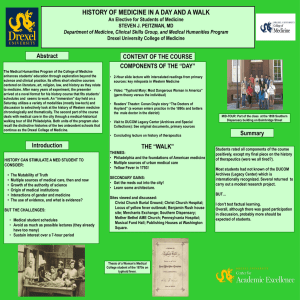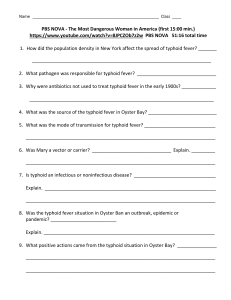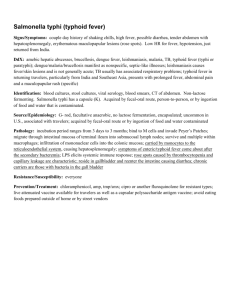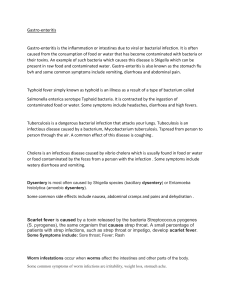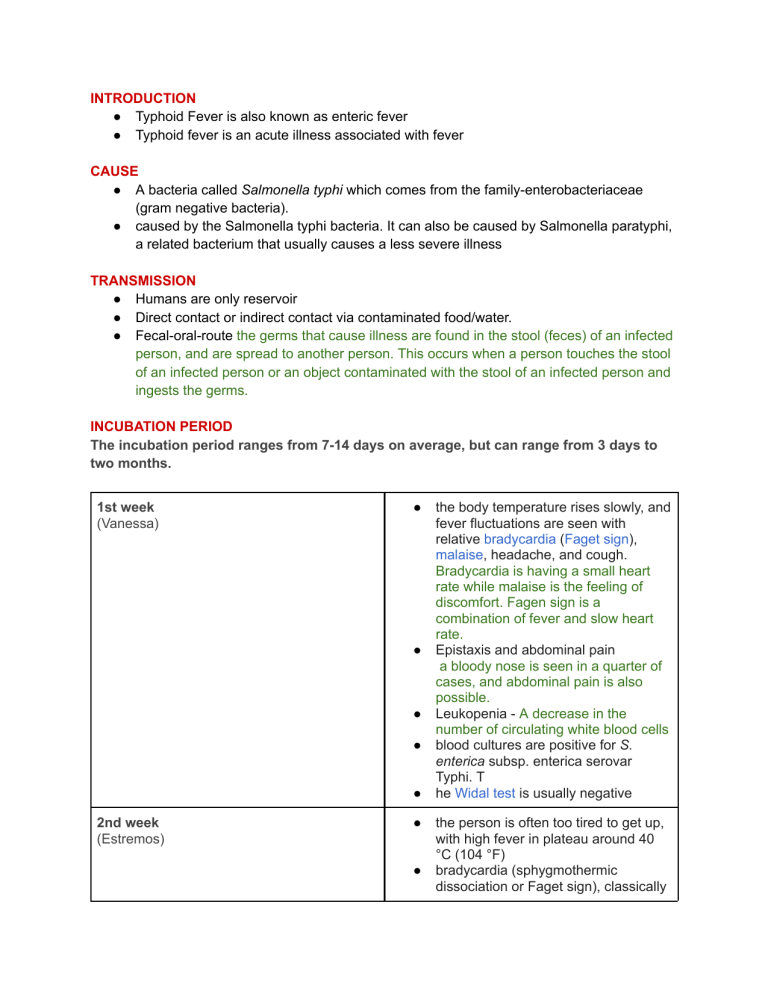
INTRODUCTION ● Typhoid Fever is also known as enteric fever ● Typhoid fever is an acute illness associated with fever CAUSE ● A bacteria called Salmonella typhi which comes from the family-enterobacteriaceae (gram negative bacteria). ● caused by the Salmonella typhi bacteria. It can also be caused by Salmonella paratyphi, a related bacterium that usually causes a less severe illness TRANSMISSION ● Humans are only reservoir ● Direct contact or indirect contact via contaminated food/water. ● Fecal-oral-route the germs that cause illness are found in the stool (feces) of an infected person, and are spread to another person. This occurs when a person touches the stool of an infected person or an object contaminated with the stool of an infected person and ingests the germs. INCUBATION PERIOD The incubation period ranges from 7-14 days on average, but can range from 3 days to two months. 1st week (Vanessa) ● ● ● ● ● 2nd week (Estremos) ● ● the body temperature rises slowly, and fever fluctuations are seen with relative bradycardia (Faget sign), malaise, headache, and cough. Bradycardia is having a small heart rate while malaise is the feeling of discomfort. Fagen sign is a combination of fever and slow heart rate. Epistaxis and abdominal pain a bloody nose is seen in a quarter of cases, and abdominal pain is also possible. Leukopenia - A decrease in the number of circulating white blood cells blood cultures are positive for S. enterica subsp. enterica serovar Typhi. T he Widal test is usually negative the person is often too tired to get up, with high fever in plateau around 40 °C (104 °F) bradycardia (sphygmothermic dissociation or Faget sign), classically ● ● ● ● ● ● ● ● 3rd week (Marxia) ● ● ● ● with a dicrotic pulse wave. Dicrotic pulse is an abnormal carotid pulse found in conjunction with certain conditions characterised by low cardiac output Delirium can occur. This delirium has given typhoid the nickname "nervous fever" Delirium is where the patient is often calm, but sometimes becomes agitated. Rose spots appear on the lower chest and abdomen in around a third of patients. Rhonchi (rattling breathing sounds) are heard in the base of the lungs. The abdomen is distended and painful in the right lower quadrant, where a rumbling sound can be heard. Diarrhea can occur in this stage, but constipation is also common. The spleen and liver are enlarged (hepatosplenomegaly) and tender, and liver transaminases are elevated. The Widal test is strongly positive, with antiO and antiH antibodies. Blood cultures are sometimes still positive The fever is still very high and oscillates very little over 24 hours. Oscillation is the movement back and fourth at a regular speed. Dehydration ensues along with malnutrition, and the patient is delirious. A third of affected people develop a macular rash on the trunk. Intestinal haemorrhage due to bleeding in congested Peyer's patches occurs; this can be very serious, but is usually not fatal. Intestinal perforation in the distal ileum is a very serious complication and often fatal. It may occur without alarming symptoms until septicaemia or diffuse peritonitis sets in. Septicaemia is when bacteria enter the bloodstream and cause blood poisoning. ● ● ● ● ● Peritonitis is a redness and swelling (inflammation) of the lining of your belly or abdomen. Respiratory diseases such as pneumonia and acute bronchitis Encephalitis inflammation of the active tissues of the brain caused by an infection or an autoimmune response. Neuropsychiatric symptoms (described as "muttering delirium" or "coma vigil"), with picking at bedclothes or imaginary objects. Metastatic abscesses, cholecystitis, endocarditis, and osteitis. Low platelet count (thrombocytopenia) is sometimes seen. RISK FACTORS ● Children and young adults ● Overcrowding ● Poor sanitation ● Work in or travel to area where typhoid fever is endemic ● Have close contact with someone who is infected or has recently been infected with typhoid fever ● Drink water contaminated by sewage that contains S. typhi TYPHOID FEVER AFFECTS Typhoid fever is most common in rural areas of developing countries where there isn’t modern sanitation. ● Countries in South and Southeast Asia, Central and South America, Africa and the Caribbean are most affected by typhoid. ● Travelers are most at risk when visiting Pakistan, India or Bangladesh. ● Children are more likely to get typhoid than adults. POSSIBLE COMPLICATIONS Health problems that may develop include: ● Intestinal hemorrhage (severe GI bleeding) ● Intestinal perforation ● Kidney failure ● Peritonitis B. Diagnosis ● A diagnosis of typhoid fever can usually be confirmed by analysing samples of blood, poo, or pee. ● These will be examined under a microscope for the Salmonella typhi bacteria that cause the condition. ● The bacteria aren't always detected the first time, so you may need to have a series of tests. ● Testing a sample of bone marrow is a more accurate way of diagnosing typhoid fever. ● But getting the sample is both time-consuming and painful, so it's usually only used if other tests are inconclusive. ● If typhoid fever is confirmed, other members of your household may also need to be tested in case you have passed the infection on to them. Widal Test The Widal test is used to identify specific antibodies in the serum of people with typhoid by using antigen-antibody interactions. In this test, the serum is mixed with a dead bacterial suspension of salmonella with specific antigens. If the patient's serum contains antibodies against those antigens, they get attached to them, forming clumps. If clumping does not occur, the test is negative. The Widal test is time-consuming and prone to significant false positives. It may also be falsely negative in recently infected people. But unlike the Typhidot test, the Widal test quantifies the specimen with titres. An advanced way to check for antibodies that your body makes against salmonella bacteria. It looks for O and H antibodies in a patient’s blood sample (serum) O Antibody Somatic appears first, rising progressively, later falling and often disappearing within a few months. Rising or high O antibody titre generally indicates acute infection. H Antibody Flagellar appears a little later but persists for longer raised H antibody helps to identify the type of enteric fever. Sample Analysis Widal test procedure involves the serum agglutination test to detect typhoid fever. /Agglutination - refers to the clumping of particles together, is an antigen-antibody reaction that occurs when an antigen (i.e., a molecule capable of triggering the adaptive immune response) is mixed with its corresponding antibody at a suitable pH and temperature/ /Agglutinins - are antibodies. They bind multiple antigens together and form a lattice-like structure seen as clumping by the naked eye. / Tube Method The Tube Widal test is more sensitive and specific than slide Widal test, especially for rule out prozone phenomena, ● ● ● ● ● ● ● Collect a blood sample from the patient and let it clot. After the clot has formed, centrifuge the sample to separate the serum from the cells. Label 4 test tubes with the patient's name and the date. Add a different dilution of the antigen solution to each of the test tubes. Add a fixed amount of the patient's serum to each test tube. Combine the contents of each test tube thoroughly. Incubate the test tubes at 37°C for 24 hours. Slide Widal Test slide Widal agglutination test is found to good alternative screening test because less time consuming, easy to perform, cost effective and can be applied in resource poor nations. ● ● ● ● ● ● ● ● ● Collect a blood sample from the patient and let it clot. After the clot has formed, centrifuge the sample to separate the serum from the cells. Place a drop of the serum on a clean glass slide and label it with the patient's name and the date. Add a drop of antigen solution (containing killed Salmonella typhi and Salmonella paratyphi) to the serum drop. Mix the two drops using a clean toothpick or glass rod, making sure they are thoroughly combined. Rotate the slide slowly for 4 minutes to allow agglutination to occur. Agglutination is the clumping of bacteria caused by the interaction between the antibodies in the serum and the antigens in the solution. Examine the slide under a microscope at 40x magnification to look for agglutination. The clumping of the bacteria indicates a positive result. In both methods, a rising titer of antibodies over time indicates a positive diagnosis of enteric fever. However, a single positive result is insufficient for diagnosis, as false positives can occur due to other infections or previous exposure to the bacteria. Therefore, the Widal test is often used with other diagnostic tests and clinical symptoms to confirm the presence of enteric fever. ● For agglutination to occur, the ratio of antigen to antibody must be similar; otherwise, clumping will not happen. Excessive amounts of antigens or antibodies in the solution may prevent agglutination; a phenomenon called prozone and postzone effect, respectively. Results ● Widal blood test is both qualitative and quantitative diagnostic analysis ● A Widal test report is more commonly known as the typhoid test report. Positive more than or equal to 1:160 S typhi O positive titre for antigen O and antigen means active infection of H typhoid fever. Active infection indicates the patient has an infection of Salmonella enterica serovar typhi. S typhi H positive there is a past infection or it shows the result of the immunized person’s serum test report. Normal When the test report lies in the Widal test normal range chart, then it is negative for the typhoid fever. If the titre value is less than or equal to 1:20, 1:40, 1:80, and less than 1:160 Negative Widal test negative means that a person does not have enteric fever, and there is another infection causing the symptoms The titre value of antigen O and H is below 1:160 in the sample. Typhoid test result lies in Widal test normal value. Titre - concentration of solution as determined by titration. The concentration of an antibody, as determined by finding the highest dilution at which it is still able to cause agglutination of the antigen. ● Titers are usually expressed as ratios, such as 1:256, meaning that one part serum to 256 parts saline solution (dilutant) results in no antibodies remaining detectable in the sample. A titer of 1:8 is, therefore, an indication of lower numbers of bacteria antibodies than a 1:256 titer. TyphiDot Test A Typhidot Test is a screening test for typhoid fever performed using a blood sample. It evaluates the presence of immunoglobulin M (IgM) in the blood. It can thus indicate the presence or absence of the Salmonella species in the blood. The Typhidot Test is a dot enzyme-linked immunosorbent assay (ELISA) that can detect antibodies IgG and IgM in the human body. The body produces these antibodies against the bacteria's outer membrane protein (OMP). The test becomes positive within two to three days of Salmonella infection. It indicates the presence of IgG and IgM in the blood. Tubex Test UBEX (IDL Biotech) is a 5 min semi quantitative colorimetric test for typhoid fever Results Results Interpretation <2 Negative 3 Inconclusive score, repeat analysis 4 Weak positive indication of current typhoid fever infection 6-10 Strong indication of current typhoid fever infection Treatment Even when the symptoms go away, people may still be carrying typhoid bacteria, meaning they can spread it to others, through shedding of bacteria in their feces. Commonly prescribed antibiotics The medicine you get to treat typhoid fever may depend on where you picked up the bacteria. Strains picked up in different places respond better or worse to certain antibiotics. These medicines may be used alone or together. Antibiotics that may be given for typhoid fever are: ● Fluoroquinolones. These antibiotics, including ciprofloxacin (Cipro), may be a first choice. They stop bacteria from copying themselves. But some strains of bacteria can live through treatment. These bacteria are called antibiotic resistant. ● Cephalosporins. This group of antibiotics keeps bacteria from building cell walls. One kind, ceftriaxone, is used if there is antibiotic resistance. ● Macrolides. This group of antibiotics keeps bacteria from making proteins. One kind called azithromycin (Zithromax) can be used if there is antibiotic resistance. ● Carbapenems. These antibiotics also prevent bacteria from building cell walls. But they focus on a different stage of that process than the cephalosporins. Antibiotics in this category may be used with severe disease that doesn't respond to other antibiotics. Vaccines Two typhoid vaccines are available: a Vi capsular polysaccharide vaccine (ViCPS) administered intramuscularly and an oral, live, attenuated vaccine (Ty21a). Both vaccines induce a protective response in 50%–80% of recipients. All four doses should be ingested at least 1 week before potential exposure. Abbreviated vaccine name (brand name, manufacturer) How it is given Number of doses recomme nded When taken How long to complete immunizatio n before travel Minimum age for vaccinatio n Booster needed Ty21a (Vivotif, Emergent BioSolutions) 1 capsule by mouth 4 Every other day 1 week 6 years Every 5 years ViCPS (Typhim Vi, Sanofi Pasteur) Injection 1 2 weeks 2 weeks 2 years Every 2 years Prevention All travelers to endemic areas are at potential risk of typhoid fever, although the risk is generally low in tourist and business centers where standards of accommodation, sanitation and food hygiene are high. Typhoid fever vaccination should be offered to travelers to destinations where the risk of typhoid fever is high. ● ● ● ● ● ● Ensure food is properly cooked and still hot when served. Avoid raw milk and products made from raw milk. Drink only pasteurized or boiled milk. Avoid ice unless it is made from safe water. When the safety of drinking water is questionable, boil it, or if this is not possible, disinfect it with a reliable, slow-release disinfectant agent (usually available at pharmacies). Wash hands thoroughly and frequently using soap, in particular after contact with pets or farm animals, or after having been to the toilet. Wash fruits and vegetables carefully, particularly if they are eaten raw. If possible, vegetables and fruits should be peeled. Control of the disease Access to safe water and adequate sanitation, hygiene among food handlers and typhoid vaccination are all effective in preventing typhoid fever. ● ● ● ● ● Water and sanitation infrastructure: safe drinking water and improved sanitation Public health measures: correctly diagnosing and treating cases, finding and treating carriers Food safety Health education: hand washing, food safety practices Vaccination: the World Health Organization recommends that countries with very high burdens of disease or high burdens of antibiotic resistant S. Typhi include typhoid vaccination in their vaccination programmes. Typhoid vaccination can also be one of the tools used for controlling outbreaks, along with providing safe water and improved sanitation and other public health measures.


